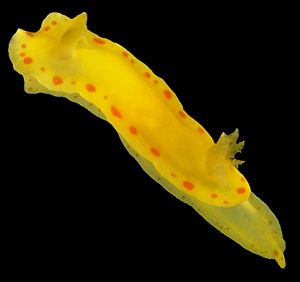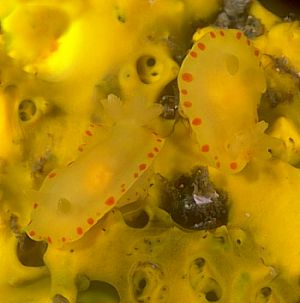

Noumea sulphurea
Rudman, 1986
Order: NUDIBRANCHIA
Suborder: DORIDINA
Superfamily: EUDORIDOIDEA
Family: Chromodorididae
DISTRIBUTION
Southern Australia (New South Wales to Western Australia)
PHOTO
UPPER: Shelly Beach, Manly, Sydney, New South Wales; 7 specimens (12, 15, 15, 16, 16, 17, 18 mm long alive), 6 m, 27 March 1984, AM C141473.
LOWER: Jibbon Head, Port Hacking, Sydney, New South Wales; 2 specimens (20, 22 mm long alive), 10 m, 5 April 1983, AM C138212. On food sponge Darwinella oxeata. Photos: Bill Rudman
RELATED TOPIC
There are some differences in colour between specimens from New South Wales and those from
southern Australia. See separate page for southern colour form. In New South Wales animals the whole of the body is a uniform bright yellow with regular orange spots around the mantle edge, sometimes touching the edge but usually just submarginal. There is also a submarginal row of orange spots around the foot, those along the side of the foot being smaller than the spots on the mantle, while those on the posterior visible part of the foot are of similar size to the mantle spots. In some smaller specimens microscopic white specks can be seen scattered over the mantle. The rhinophores and gills are translucent yellow and the rhinophore club is tipped with translucent white. The gills are simple and arranged in a circle around the anus. The mantle glands are single and ovate, arranged in a submarginal band around the mantle edge.
Noumea sulphurea has a wide distribution around southern Australia from New South Wales to Fremantle in Western Australia. Animals from Tasmania, Victoria and South Australia [see separare page] differ from those from Western Australian and New South Wales in having very noticeable white specks over the mantle and translucent, rather than opaque, orange spots.
In New South Wales and Tasmania this species is always found on yellow species of the sponge genus Darwinella identical in colour to the nudibranch. In Victoria, South Australia and Tasmania there is another species of Noumea, N. closei which is also found on the same, or very similar looking sponges. The only external difference between the two species of Noumea is that there are a few orange spots scattered over the central part of the dorsum as well as around the edge in N. closei. When preserved in formalin N. sulphurea loses its colour and becomes a pale translucent pinkish colour. Noumea closei on the other hand darkens to a deep reddish-brown almost black colour.
Reference:
• Rudman, W.B. (1986) The Chromodorididae (Opisthobranchia: Mollusca) of the Indo-West Pacific: Noumea flava colour group. Zoological Journal of the Linnean Society, 88: 377-404.
Rudman, W.B., 2001 (March 28) Noumea sulphurea Rudman, 1986. [In] Sea Slug Forum. Australian Museum, Sydney. Available from http://www.seaslugforum.net/factsheet/noumsulp1
